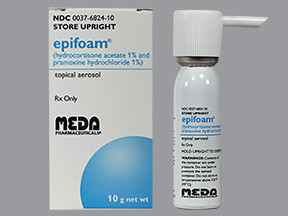PRAMOXINE/HYDROCORTISONE FOAM - TOPICAL
PHONETIC PRONUNCIATION: (pram-OX-een/hi-dro-KOR-tih-sown)
COMMON BRAND NAME(S): Epifoam
GENERIC NAME(S): hydrocortisone acetate/pramoxine HCl
Uses
USES: This product contains 2 medications. Pramoxine is an anesthetic that is used on the skin to relieve minor pain, itching, and discomfort. It works by temporarily numbing the area. Hydrocortisone is a corticosteroid that reduces redness, swelling, and itching. This combination medication is used to treat certain skin conditions such as eczema, psoriasis, rash, cuts, scrapes, insect bites, or minor burns. This product is available in different strengths and forms (e.g., aerosol foam, cream, ointment, lotion). The type of medication used depends on the location of your condition and the type of skin problem being treated. Creams are the most frequently used form. Lotions may be better for hairy areas. Ointments may be better for dry areas and when a stronger effect or skin protection is desired. Foams can be easier and less messy to apply.
How to use PRAMOXINE/HYDROCORTISONE FOAM - TOPICAL
HOW TO USE: Follow all instructions in the product package, including any instructions for cleaning the container after use. Before each use, shake the foam canister well for 5-10 seconds. Before applying the medication, clean the affected area with mild soap and water, rinse well, and pat dry. Apply a small amount of the foam to the affected area, usually 3-4 times a day or as directed by your doctor. You may need to press the applicator a few times before foam appears. You can apply the foam directly to the area, or apply a small amount to a pad and use it to apply the foam to the affected area. Do not use the foam or insert any part of the foam canister in the anus or vagina. This medication is for use on the skin only, as directed by your doctor. Do not use more of this product, use it more often, or keep using it longer than prescribed because doing so may increase the risk of side effects. Wash hands immediately after use, unless the area being treated includes the hands. Avoid getting the product in your eyes, nose, ears or mouth. If the medication gets in these areas, rinse the area immediately with clean water. Do not cover the area with waterproof bandages or plastic, apply heat, or use the product on large areas of the body unless directed to do so by your doctor. If used in the diaper area on an infant, do not use tight-fitting diapers or plastic pants. These may increase the risk of side effects. How often the medication is applied and for how long depends on your condition and response to treatment. Use this medication regularly in order to get the most benefit from it. To help you remember, use it at the same times each day. If you have been using this medication for a long time or in high doses, do not suddenly stop using it without your doctor's approval. Some conditions may become worse when this drug is suddenly stopped. Your dose may need to be gradually decreased. Tell your doctor if your condition does not improve or if it worsens.
Side Effects
Precautions
Interactions
Overdose
Images
Reviews
Disclaimer
IMPORTANT: HOW TO USE THIS INFORMATION: This is a summary and does NOT have all possible information about this product. This information does not assure that this product is safe, effective, or appropriate for you. This information is not individual medical advice and does not substitute for the advice of your health care professional. Always ask your health care professional for complete information about this product and your specific health needs.

No Reviews Yet